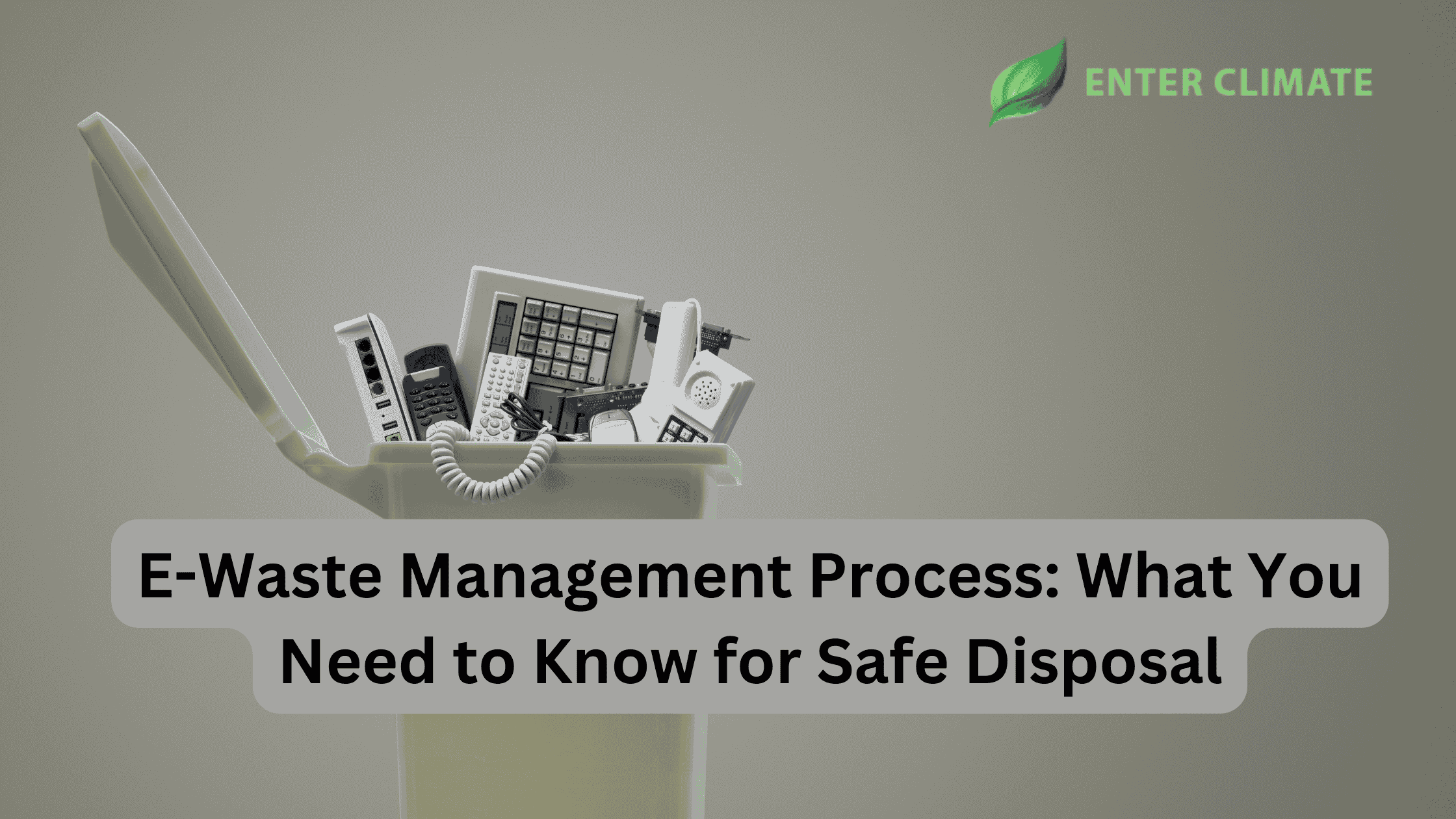As technology continues to advance at an unprecedented pace, the generation of electronic waste, or e-waste, has become a major environmental challenge. With more people and businesses relying on electronic devices like smartphones, laptops, and televisions, proper e-waste management is now more important than ever. In India, where electronic consumption is on the rise, understanding the e-waste management process is crucial to ensure safe disposal and recycling. In this blog, we will guide you through the e-waste management process, providing a step-by-step approach to safely dispose of electronic waste and reduce its environmental impact.
What is E-Waste?
E-waste refers to any discarded electrical or electronic devices that are no longer in use, either due to malfunction, obsolescence, or damage. This includes a wide range of products such as:
- Smartphones
- Laptops and desktops
- Televisions and monitors
- Washing machines and refrigerators
- Batteries
- Cables and chargers
E-waste contains valuable materials like metals (gold, silver, copper) and hazardous substances (mercury, lead, cadmium). If not properly managed, these substances can contaminate the environment, harming ecosystems and human health.
The Importance of E-Waste Management
Proper e-waste management is essential for several reasons:
- Environmental Protection: Improper disposal can lead to the contamination of soil, water, and air with toxic substances.
- Resource Conservation: E-waste contains valuable raw materials like metals, plastics, and glass, which can be recycled and reused.
- Health Safety: Exposure to hazardous materials in e-waste, like lead and mercury, can cause serious health issues.
- Legal Compliance: In India, the government has set guidelines for e-waste management, which must be followed by consumers and businesses alike.
The E-Waste (Management) Rules, 2016 laid down by the Ministry of Environment, Forest, and Climate Change (MoEFCC) and amended in 2018, provide a legal framework for managing e-waste in India. The rules require producers, consumers, and recyclers to follow specific guidelines to reduce the environmental impact of e-waste.
E-Waste Management Process: Step-by-Step Guide
Managing e-waste is a multi-step process that involves various stakeholders. Here’s a breakdown of the e-waste management process from disposal to recycling:
1. Collection of E-Waste
The first step in the e-waste management process is the collection of discarded electronic devices. The collection process can be done by:
- E-Waste Collection Centers: These are specialized centers where individuals and businesses can drop off their electronic waste.
- Take-Back Services by Manufacturers: Many electronic manufacturers offer take-back programs, where consumers can return their old devices for proper disposal or recycling.
- Municipal Collection Programs: Local authorities may organize collection drives for e-waste disposal.
Consumers must ensure that they dispose of their old electronic devices at authorized collection points to ensure that they are handled properly and not dumped illegally.
2. Segregation and Sorting
Once e-waste is collected, it is transported to e-waste recycling facilities where it undergoes segregation and sorting. This step is crucial as it helps to separate different materials, including:
- Valuable Materials: Items like gold, copper, silver, and palladium, which can be recycled and reused.
- Hazardous Substances: Materials like mercury, cadmium, and lead, which need to be handled with care to avoid environmental contamination.
- Non-Recyclable Waste: Components like plastic and glass that may need to be disposed of in an eco-friendly manner.
Proper segregation reduces the risk of contamination and ensures that valuable resources are recovered and reused.
3. Dismantling and Shredding
In this step, the electronic devices are dismantled into smaller parts, such as:
- Printed Circuit Boards (PCBs)
- Batteries
- Metals and Plastics
These parts are then shredded to make them easier to process. The dismantling process also helps in removing hazardous components such as batteries and CRT screens from monitors and televisions. Dismantling must be done carefully to prevent exposure to harmful substances like lead and mercury.
4. Recycling
Once the e-waste has been sorted and dismantled, it moves on to the recycling phase. In this stage, materials like:
- Metals: Copper, aluminum, gold, and silver are extracted and sent to metal refineries for reuse.
- Plastics: Recyclable plastics are processed and converted into new plastic products.
- Glass: Glass components are cleaned and reused for various industrial purposes.
The recycling process helps to recover valuable materials and reduces the need for new raw materials, which in turn conserves natural resources and energy.
5. Disposal of Non-Recyclable Waste
Not all components of e-waste can be recycled. Some parts, like certain plastics and composites, may not be reusable. These materials are then disposed of safely in designated landfills or incineration facilities. However, it’s important that these processes are carried out in an eco-friendly manner to minimize environmental damage.
6. Responsible Disposal and Final Processing
Finally, any remaining non-recyclable waste is subjected to responsible disposal to ensure that no hazardous substances leak into the environment. This may include:
- Landfill Disposal: Non-recyclable items that don’t pose significant environmental hazards may be sent to landfills.
- Incineration: Some waste may be incinerated at high temperatures to break down harmful substances.
7. Consumer Awareness and Education
Consumers play a vital role in the e-waste management process. They must be made aware of how to properly dispose of their electronic devices and encourage others to do the same. Government initiatives and awareness campaigns help educate consumers about responsible e-waste disposal methods.
E-Waste Recycling and the Role of Manufacturers
E-waste management is a shared responsibility, with manufacturers being crucial stakeholders in the process. According to the E-Waste (Management) Rules, 2016, producers of electronic products are required to:
- Set up collection centers for the take-back of old devices.
- Provide clear guidelines for proper disposal of their products.
- Provide a certificate of recycling to consumers and ensure that their waste is recycled responsibly.
Many manufacturers now offer buy-back schemes and take-back programs that encourage consumers to return their old devices for recycling. This is a proactive approach to reducing e-waste and conserving valuable resources.
Conclusion
E-waste management is an essential process to protect our environment and health. By following the proper steps—from collection to recycling—we can reduce the environmental impact of discarded electronics and recover valuable materials. Consumers, manufacturers, and recyclers must all work together to create a sustainable future by responsibly managing e-waste. By understanding the e-waste management process, we can play our part in creating a cleaner, greener environment for future generations.
FAQs
1. Why is e-waste management important?
E-waste management is crucial because improper disposal can lead to environmental contamination and health risks due to hazardous substances like lead and mercury found in electronic devices.
2. Can I recycle my old electronic devices at home?
No, recycling e-waste at home is not safe. It’s essential to take your old devices to authorized collection points or recycling centers to ensure safe handling and disposal.
3. What are the laws regarding e-waste management in India?
The E-Waste (Management) Rules, 2016, lay down the legal framework for managing e-waste in India. These rules outline the responsibilities of producers, consumers, and recyclers in handling e-waste responsibly.



